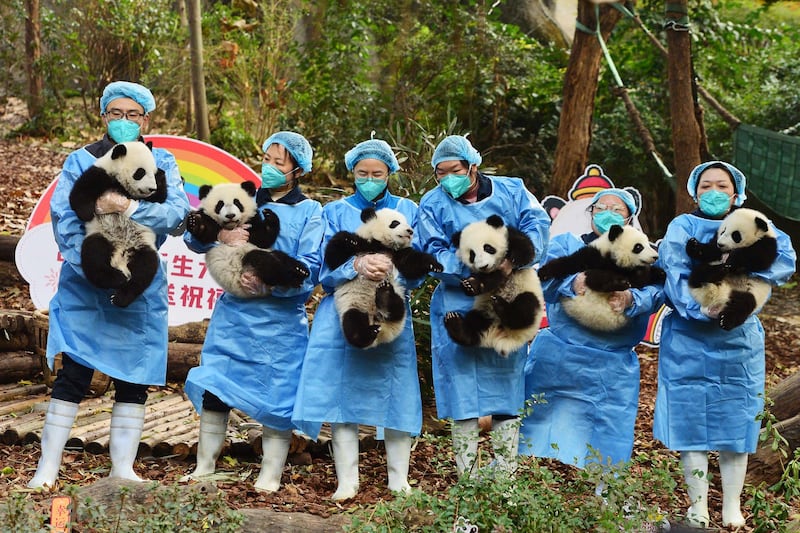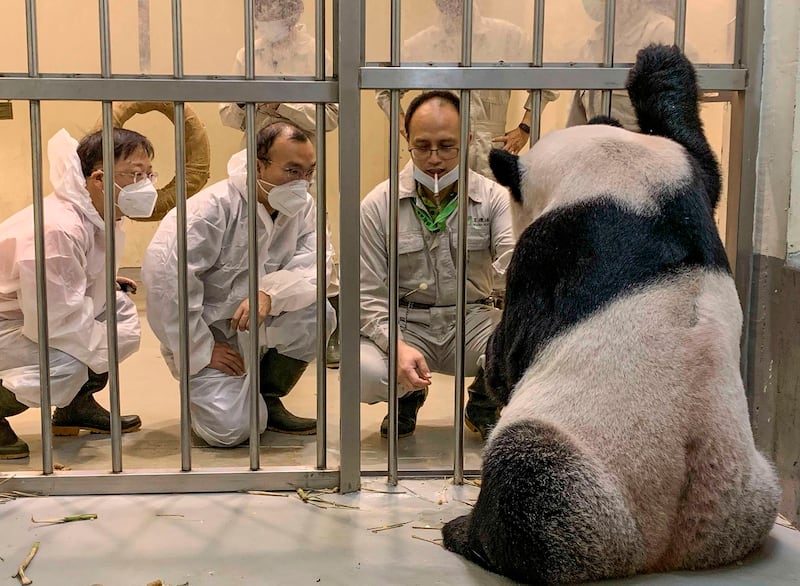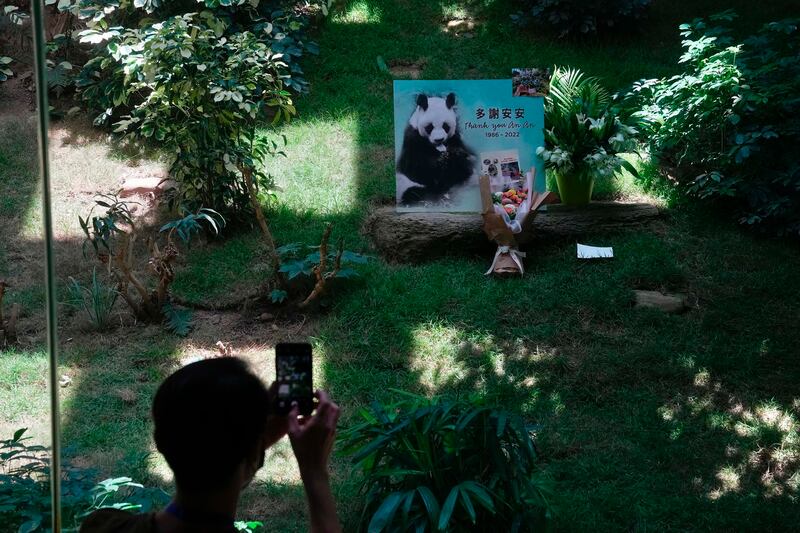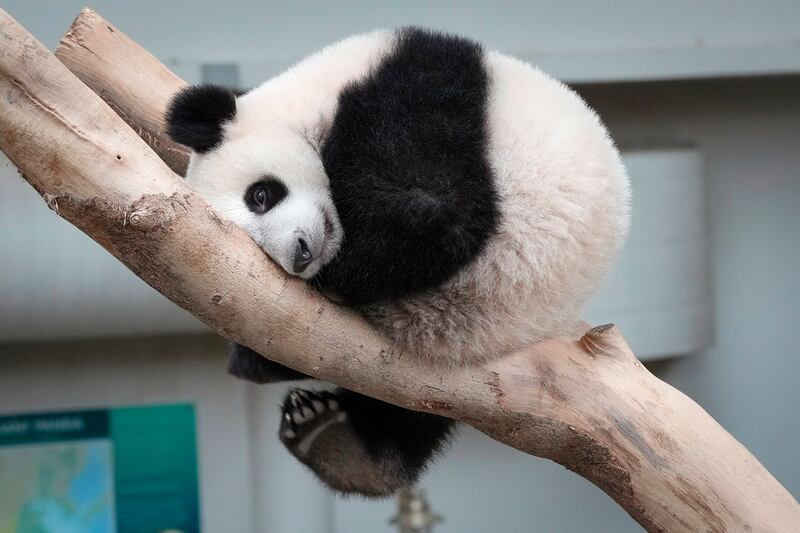In honor of the World Cup, the Middle East received its first giant pandas -- "Jingjing" and "Sihai" -- sent by China as a diplomatic gift honoring the host nation Qatar in November 2022.
The animals -- named “Suhail” and “Thuraya” in Arabic -- have been housed in a lavish, air-conditioned building in Al Khor Park and Zoo where they can lounge on manicured lawns and eat freshly harvested bamboo while being photographed by crowds of tourists from above.
Just two days after their arrival, Taiwan's panda Tuan Tuan -- gifted to the democratic island in 2008 at a time of warmer ties -- was euthanized by a visiting team of expert veterinarians from China after developing a brain lesion.
According to researcher and author Long Yuanzhi, the life stories of China's "gift" pandas follow the same script -- bred in captivity in the southwestern province of Sichuan, shipped out to a foreign country, where they live out their lives in a zoo and are eventually put to sleep.
"Giant pandas are basically wild animals, so they are going to be in captivity regardless of what conditions humans provide for them," Long said in a recent interview with Radio Free Asia. "Taiwan is a subtropical region, so it isn't a suitable habitat for pandas."

"This is pretty obvious, but this fact is ignored by the media, the general public and by governments, who prefer to shift the focus away from animal welfare, animal rights and conservation," Long said.
Long, who has been to 10 different nature reserves and protected habitats in Sichuan to pursue her research, including the Wolong reserve where Tuan Tuan was born, and the Shenshuping conservation center that bred Jing Jing and Sihai.
$1 million annually
Her recent book, titled "In Search of Zootopia: A frontline documentation of cross-border animal protection," is packed with her observations of pandas in zoos around the world.
The term "gifts" is something of a misnomer, says Long, explaining that China stopped giving away the creatures in 1982 in favor of 10-year leases framed as "scientific research cooperation" projects.
Zoos wanting to host a pair of pandas are expected to pay around U.S.$1 million annually for the privilege, and are vetted for their financial status before the agreements are signed.

While China says the money goes to fund panda research and conservation work, there is no framework under which host nations can check or observe where their money ends up.
The arrangement has been popular, with zoos happy with the large numbers of visitors that pandas typically attract.
However, with zoos' finances battered as the COVID-19 pandemic causes a slump in global tourism and visitor numbers, there have been rumors that Finland and Canada are considering sending their pandas back ahead of time.
Tuan Tuan's personal back-story also highlights wider problems with the panda "gifting" program.
His father Pan Pan was the official mascot of the 1990 Asian Games, and sired more than 130 cubs, more than a quarter of captive pandas by 2017.
Wild pandas
The original group of 46 pandas used to start the captive breeding program were all from the wild, but the narrowing of the gene pool means that the next generation could be at risk of genetic degeneration.
Faced with a genetic dead end from successive generations of captive breeding, China's panda conservation chief Duan Zhaogang announced in October that the program will start to refocus on reintroducing captive pandas to the wild, and conserving the species in their natural habitat.

But Long doesn't see how this can work.
"Like other animals, giant pandas raised in captivity often lack the ability to survive in the wild," she said, citing the death of Xiang Xiang, the first giant panda to be released, in a fight with wild pandas.
The wild population currently stands at just over 1,800, with around 700 giant pandas in captivity around the world.
The vast majority of captive pandas will never be reintroduced, and will live out their lives in zoos, she said.
Another issue that scarcely gets a mention in the cutesy media coverage is that the process of artificial insemination is about as far from natural mating and pair-bonding as it's possible to get.
"After the male panda is anesthetized, then something like a corn cob is inserted into its anus, and the rectum is electroshocked to make it involuntarily ejaculate," Long said. "The female panda will also be artificially inseminated under general anesthetic."
Some pandas have died as a result of the semen extraction procedure, while female pandas have their estrus period manipulated, and are forcibly separated from their cubs a year earlier than they would separate in the wild, so they can be brought back into estrus to conceive once more.
Yet conservation centers still insist on artificial insemination rather than natural breeding to increase the chances of a pregnancy, Long said, citing multiple interviews with staff at those facilities.
Long said the entire panda conservation industry in Sichuan began with attempts to "rescue" wild pandas out of fears they would starve to death amid the large-scale withering of bamboo forests in the 1970s and 1980s.

Communist Party propaganda has always painted the animals as in need of rescue by humans, Long said, citing a government-backed "folk song" about pandas.
"The idea of rescuing them from the wild is absurd, from the perspective of science communication," she said. "It is an appropriation of natural knowledge and based on false causality."
"Even today, very few people realize the lessons that this history can teach us."
Long has come to the conclusion that the opposite is true.
"Giant pandas don't need humans: humans need giant pandas," she said.
Translated by Luisetta Mudie. Edited by Malcolm Foster.
